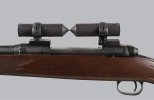Hugnot
Well-Known Member
I like Burris Signature rings with the plastic, concentric or eccentric inserts.
When using clamp-on rings with Ruger M77 MKII receivers of the investment casting type I always lap rings then mark the bottom of each ring with the last 3 of the S/N for use with a certain receiver. The Ruger rings are also of the investment casting type. I seem to remember tolerances from investment castings are within .007 inches. Lapping shows much variation of Ruger ring ID.
For newer CNC produced rings I don't see much or any advantage from lapping.
I wish Burris would make Signature rings for Ruger M77 MKII's. Having a Ruger with a pic rail would solve many problems.
Reuse them provided they were lapped as a pair.
When using clamp-on rings with Ruger M77 MKII receivers of the investment casting type I always lap rings then mark the bottom of each ring with the last 3 of the S/N for use with a certain receiver. The Ruger rings are also of the investment casting type. I seem to remember tolerances from investment castings are within .007 inches. Lapping shows much variation of Ruger ring ID.
For newer CNC produced rings I don't see much or any advantage from lapping.
I wish Burris would make Signature rings for Ruger M77 MKII's. Having a Ruger with a pic rail would solve many problems.
Reuse them provided they were lapped as a pair.

